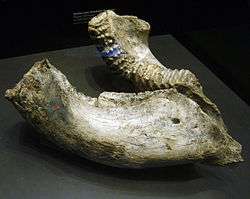Palaeoloxodon recki
| Palaeoloxodon recki Temporal range: Pliocene to Pleistocene | |
|---|---|
 | |
| Jaw, Museum für Naturkunde, Berlin | |
| Scientific classification | |
| Kingdom: | Animalia |
| Phylum: | Chordata |
| Class: | Mammalia |
| Order: | Proboscidea |
| Family: | Elephantidae |
| Genus: | Palaeoloxodon |
| Species: | †P. recki |
| Binomial name | |
| Palaeoloxodon recki Dietrich, 1894 | |
| Synonyms | |
|
Elephas recki | |

Palaeoloxodon recki is an extinct species related to the Asian elephant Elephas maximus. At up to 14 feet (4.27 metres) in shoulder height, it was one of the largest elephant species to have ever lived. It is believed that P. recki ranged throughout Africa between 3.5 and 1 million years ago. The Asian Elephant is the closest living relative of P. recki. P. recki was a successful grass eating elephant that lived throughout the Pliocene and the Pleistocene until it was pushed to extinction, perhaps by competition with members of the genus Loxodonta, the African elephants of today.
An male of P. recki from Koobi Fora was 40 years old when it died. At that age it was 4.27 metres (14.0 ft) tall and weighed 12.3 tonnes (12.1 long tons; 13.6 short tons).[1]
Subspecies
M. Beden [2][3][4] identified five subspecies of Palaeoloxodon recki, from oldest to youngest:
- P. r. brumpti Beden, 1980
- P. r. shungurensis Beden, 1980
- P. r. atavus Arambourg, 1947
- P. r. ileretensis Beden, 1987
- P. r. recki (Dietrich, 1916)
New research indicates that the ranges for all five subspecies overlap, and that they are not separated in time as previously proposed. The research also found a wide range of morphological variation, both between the supposed subspecies and between different specimens previously identified as belonging to the same subspecies. The degree of temporal and geographical overlap, along with the morphological variation in P. recki suggests that the relationships between any subspecies are more complicated than previously indicated.[5][6]
References
- ↑ Larramendi, A. (2016). "Shoulder height, body mass and shape of proboscideans" (PDF). Acta Palaeontologica Polonica. 61. doi:10.4202/app.00136.2014.
- ↑ Beden, M. 1980. Elephas recki Dietrich, 1915 (Proboscidea, Elephantidae). Èvolution au cours du Plio-Pléistocène en Afrique orientale]. Geobios 13(6): 891-901. Lyon.
- ↑ Beden, M. 1983. Family Elephantidae. In J. M. Harris (ed.), Koobi Fora Research Project. Vol. 2. The fossil Ungulates: Proboscidea, Perissodactyla, and Suidae: 40-129. Oxford: Clarendon Press.
- ↑ Beden, M. 1987. Les faunes Plio-Pléistocène de la basse vallée de l’Omo (Éthiopie), Vol. 2: Les Eléphantidés (Mammalia-Proboscidea) (directed by Y. Coppens and F. C. Howell): 1-162. Cahiers de Paléontologie-Travaux de Paléontologie est-africaine. Centre National de la Recherche Scientifique (CNRS). Paris.
- ↑ Todd, N. E. 2001. African Elephas recki: Time, space and taxonomy. In: Cavarretta, G., P. Gioia, M. Mussi, and M. R. Palombo. The World of Elephants, Proceedings of the 1st International Congress. Consiglio Nazionale delle Ricerche. Rome, Italy. Online pdf
- ↑ Todd, N. E. 2005. Reanalysis of African Elephas recki: implications for time, space and taxonomy. Quaternary International 126-128:65-72.